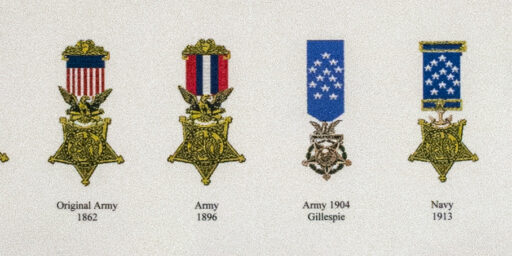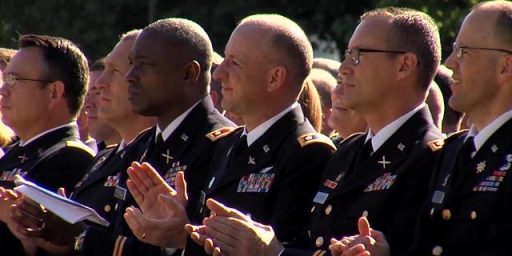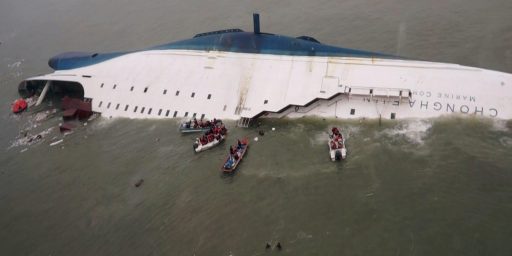NEWS FROM THE FRONT
Andrew Olmsted reproduces and comments on an after action review from a squadron commander in the 3rd Armored Cavalry Regiment in Iraq. Some interesting stuff, although quite laden with jargon that will be unfamiliar to those without military backgrounds.
A short glossary:
Squadron: Cav talk for “battalion.”
Cav/Cavalry: No, they don’t have horses. Indeed, this is more a “state of mind” than a real branch. Some light armor and aviation branch–and, indeed, some artillery–units consider themselves to be part of the lineage of the horse cavalry because of their speed. They affect some of the heraldry of the old cav by wearing Stetson hats and yellow scarves and such with their dress uniforms.
The S’s–these are the battalion staff officers. The same nomenclature applies to division (G-) and joint command (J-) level staffs.
S-1: Adjutant The guy in charge of personnel matters such as awards, promotion, leave, staff duty assignments, and the like. Usually a mediocre captain or an excellent first lieutenant.
S-2: Intelligence At batallion level, not a professional M.I. branch officer but a lieutenant or senior NCO who is in charge of disseminating intel from higher headquarters, maintaining security clearances, and various aspects of physical security.
S-3: Operations The most coveted and important of the staff jobs. Either a very senior captain or a junior major who has already commanded a company-sized unit. Responsible to managing the unit’s training schedule and for planning combat operations.
S-4: Supply. Generally, this is a very junior captain who hasn’t commanded yet and who probably doesn’t know much about supply. Like the S-1, he’s not a professional Quartmaster branch officer but rather a combat arms guy from the same branch as the unit specialty (i.e., infantry, artillery, or armor) who’s filling a slot until he can get a real job–command. He’s usually got a warrant officer who is a professional QM guy that serves as the property book officer to advise him.
(via e-mail from Joe Katzman)
Update (1154): See the discussion in the comments section. Andrew takes exception to some of my comments, which are based on my particular experience. The danger of drawing from one’s own dated experience is that 1) it was anomolous or 2) that things have changed over the years.
Also, just to add to the confusion, there are more “numbers” on the higher staffs.
J-5: Strategic Plans and Policy
J-6: Command, Control, Communications, and Computer Systems
J-7: Operational Plans and Joint Force Development
J-8: Force Structure, Resources, and Assessment
J-9: Joint Experimentation
(These seem subject to change, as I’ve seen variations. These are from the JCS site.)





The acronym for staff positions (in the Infantry at least) was PITS. Personnel, Intelligence, Training and Supply. At least in the unit I was familiar with, the S-1 was a very important guy as he was the Battalion Commander’s right hand man.
Yeah–the S-1 is important because of all the paperwork. The -1 and -3 are the most prestigious of the staff positions, with the -3 being much more senior.
James, I don’t know what unit you were in, but I’ve never been in a unit where the -1 was considered a prestigious position. That’s your basic scut job. Important work, and it does keep you in tight with the commander, but very few officers I’ve known have enjoyed the job.
Also, I should note the battalion S-3 is a major’s slot. The only time a captain will fill it is when the unit is short a major for some reason. Interestingly enough, when a captain does fill the slot, he’s usually a junior captain. The battalion’s senior captains are almost always the company commanders. And the S-2 is an MI captain’s slot, with an MI lieutenant as his assistant.
Andrew,
Interesting. I was with 1/27 FA (MLRS) in Babenhausen from 1989-92. In that particular case, it depended. The job was held–as your piece suggests appropriate–by three lieutenants who were on the fast track. It was then held by a very competent lieutenant who was then promoted to captain. It was clearly not a prestige assignment for someone at the captain level.
So, in my limited experience, it’s a great job to get as an LT–you’ve already had the prestige jobs by then–but it sucks as a captain.
And very interesting on the -2 slot. We never had an MI guy for the position nor were we authorized one so far as I know. When I arrived, the job was held by an E-7 on his way to retirement and later by two first lieutenants on their way out of the Army. I don’t know if that was anomolous to that particular TOE or if things have just changed over the years.
James,
The S-1 was almost always filled with a very good officer, because the battalion commander wanted to have a good guy as his right hand man. We just all viewed it as a lousy job to have, because it entailed a great deal of boring, repetitive paperwork. But I suspect S-1s do well afterwards, because their commanders take care of them when they leave.
As for the S-2, it may vary from armor to FA. The Army may have decided that FA battalions don’t need MI officers, for whatever reason. That doesn’t make much sense to me, but the Army has its own reasons. All I can say for certain is that every armor battalion to which I’ve been assigned has had two MI officers on the MTOE: the S-2, a captain, and the tactical intelligence officer, a 2LT.
Andrew: Interesting. Which makes some sense, since it gives MI junior officers something to do. Indeed, in my unit, the only MI officer we had was a captain on brigade staff.
I my Cav unit (11th ACR), NCO’s and officers could wear spurs on certain days if they had completed a Spur Walk (which was much like an EIB badge- though probably not as rigorous).
FWIW- The Cav was the most fun I had in the military.
John: I think Cav gets it right, actually. Like the Marines, they manage to build esprit de corps through their traditions. The artillery mainly had stupid stuff like dinings out but very little in the way of fun rituals. The only thing comparable was the Saint Barbara event, but I found it fairly lame, too, since it often became a gimme.
James,
I was a member of 3ACR is the late 90s. I wouldn’t call them a light unit in any case. Abrams, Bradleys and Apaches are never light. What they don’t have is the support elements that the Division has.
Jim: Right. I should have said “relatively” light, I guess. Not really such a thing as a “light” tank. 😉
—